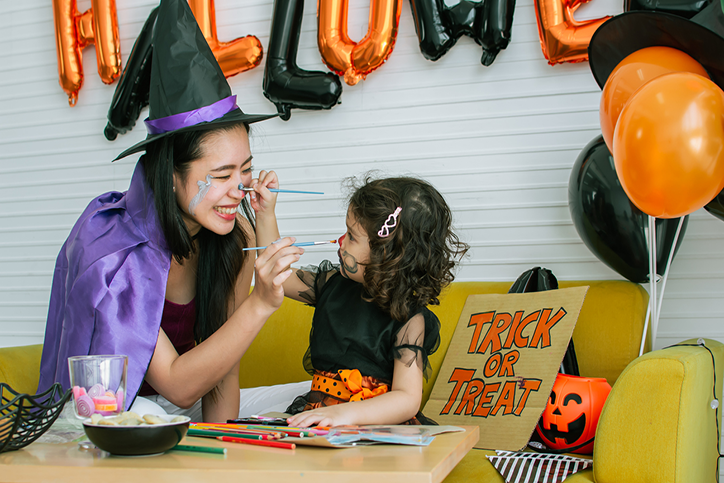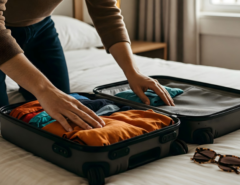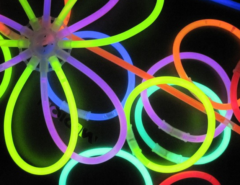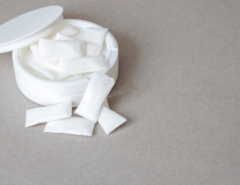Is your little ghost or ghoul ready to go trick or treating? Are you having a Halloween party? Let’s review some commonly encountered Halloween hazards!
Glow Sticks
Glow sticks are one of the most common things we hear about at the Maryland Poison Center during Halloween. The chemicals in the glow sticks are bad tasting and can be irritating to the skin, eyes, and mouth. Thankfully, most glow sticks do not contain enough chemical to cause serious injury if a child ingests it. To prevent injury, do not chew on or open glow sticks.
Candy
Poisoned candy is a myth. Investigated cases of suspected poisoned candy have revealed another health concern. Parents should inspect any candy the child receives. Do not allow children to eat candies that are unwrapped. Only take and eat homemade treats from someone you know and trust. Give children a snack or light meal before trick or treating so they are not tempted to eat the candy prior to your inspection. Read more about Halloween candy in a previously posted blog.
Bloomed chocolate is safe to eat. The white coating is simply caused by temperature changes.
Dry Ice
Dry ice is a popular addition to both the punch bowl and outdoor displays to create a smoky effect. However dry ice must be handled with care. Dry ice causes burns and frostbite-like wounds if handled without the proper protection. Wear gloves if you are going to handle dry ice. When adding dry ice to a punch bowl, do not touch or chew on chunks in the bowl or your cup. Once dry ice melts in punch, it is non-toxic, and the drink is safe to consume.
Alcohol
Be sure to clean up alcoholic drinks before going to bed as children may get up in the morning and mistake it for their beverage. Even during parties, keep an eye on alcoholic drinks and keep them out of reach of children.
Young children react differently to alcohol than adults. Children may experience low blood sugar after ingesting alcohol. If their blood sugar gets too low, it can lead to seizures and coma. If you think a child may have drunk alcohol, call the poison center right away. Do not wait for symptoms to call.
Makeup and Face Paints
There are a wide variety of makeup and paints used during the Halloween season. Read the label and follow directions before applying any product to your skin. Only use products that are intended to be used on the skin. Before applying makeup all over, test it on a smaller area to make sure it does not cause itching or irritation. Be sure to wash all makeup off immediately after you are finished trick-or-treating, or the party is over. When applying these products, avoid the eyes and mouth. Small amounts of makeup that get into the mouth is not a problem. However, getting a small amount of makeup in the eye will likely cause burning, tearing, and redness. If this happens, rinse the eye with lukewarm water for 15 minutes, then call the poison center. Once finished with the product, store it up, away, and out of sight.
Matches
Matches are frequently used to light candles in jack-o’-lanterns and various luminaires along sidewalks and homes. Match heads contain chemicals that can be dangerous if ingested in large quantities. These chemicals can cause irritation, nausea, vomiting.
Candles
If consumed, candles may cause stomach upset and loose stools. Ingesting a large quantity of candles can sometimes lead to an obstruction (block) of the intestines.
Batteries and Magnets
Costume accessories, small toys, and non-candy treats given out at this time of year may contain batteries or magnets. Battery ingestion can be very serious in a child, especially if it’s a button battery. These batteries can cause serious burns to a child’s throat in about two hours. If a child ingests a battery, immediately contact the poison center for guidance. Magnets are a risk if ingested with a piece of metal or another magnet. Magnets can attract each other (or metal) across the intestines and stomach and pinch those organs. This can lead to severe internal injury. Always call the poison center if a child ingests a magnet.
While not poison related, we wanted to touch on a few other hazards to ensure that you and your family have a safe Halloween.
Cars
Children are at risk for being struck by cars traveling house to house for treats. Have children use designated sidewalks and crosswalks. Walk in groups for safety. Use reflective or bright colored clothing or tape on Halloween costumes to make children more visible to motorists.
Fires
With candles present in outdoor pumpkin displays and capes and hats waving in the wind, there is a potential for clothing to catch fire. Here are some fire safety tips from The National Fire Protection Association:
- Use battery operated lights when possible.
- Choose costumes that do not have long, draping, flowing fabrics.
- Teach children proper stop, drop, and roll techniques.
- Keep decorations (especially those made of paper) away from heat sources and flame.
- Keep exits clear.
- Be sure your home smoke detectors are working.
No matter what tricks or hazards your little monster encounters on Halloween, poison specialists at the Maryland Poison Center are available 24/7 at 1-800-222-1222.
Amber Ferrell, PharmD
Certified Specialist in Poison Information





Leave a Reply